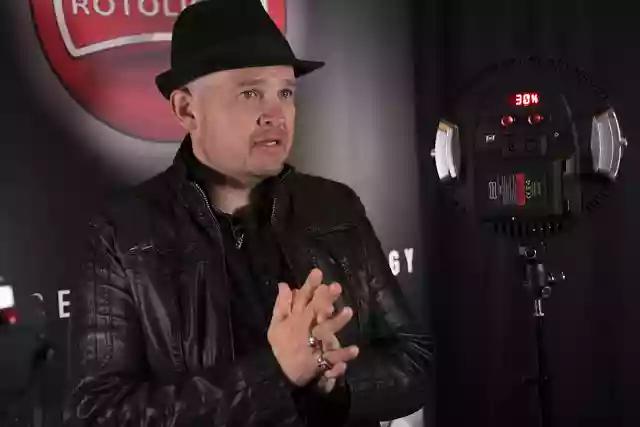- Call us: 01444 237070
- Contact Us
- Stores
- Sign In / Register
-
- Back
- Used Cameras
- Used Accessories
- Used Lenses
- Used Video
- Used Film Equipment
- Used Stock Alert
- Used Blank Test
- Sell or Part Exchange
- Used Clearance
- Recently Added Used Equipment
- Park Picks
- All Used Black Friday Deals
- Faulty
- Trade-In
- Blog
- New in
- Call us
- Contact us
- Stores
- Sign in
- Categories
- Tips & Inspiration
- Reviews
- News
- Events
- Features
- Buying Guides
- Competitions
How Rotolight are leading the LED revolution

The smell of revolution hangs thick in the air, and we want you to know about it. We're talking about the LED lighting revolution of course! We've secured exclusive interviews with key players Jason Lanier and Rotolight.
We took a trip to Pinewood Studios, the home of James Bond, to see how Rotolight are tackling traditional thinking with their range of award-winning LED lights. Armed with the superb mirrorless Sony a7RIII, we attended a ‘Master of Light’ workshop with Youtube superstar and acclaimed photographer Jason Lanier.
Bouncing flash, using large modifiers, playing about with diffusers. These tried and tested techniques are staple to studio lighting as we know it. Yet when we think about what these techniques set out to achieve, it is to add complimentary, diffused light to your subject.
Why waste time and effort adding layers of diffusion to a powerful light, when you can just use a softer light in the first instance?

Should I choose continuous lighting or high speed sync?
Using continuous lighting for still images has many benefits – it's akin to shooting in steady natural light. This takes the guesswork out, speeding up your workflow – you know where shadows are going to fall on your subject's face, and can correct this before the image is taken.
Sounds ideal, but there are restrictions with continuous lighting when using traditional strobe lights – namely a lack of power, and excessive heat generated. It's rare that a sweaty model is the desired look!
Using a flash has its benefits still – the extra power is perfect for high speed sync shots, and if you are shooting in bright daylight you may need the power to overcome the sun.
So traditionally you either choose between the two systems - or carry both. The Rotolight setup combines continuous with high speed sync - you can flick between the two with a switch of a button. So if you shoot both video and stills, this is perfect.

How does LED lighting benefit a photographer?
So why use LED? For starters, there is no single light source, so the light is naturally dispersed, reducing heavy cast shadows. The Neo 2 has 192 individual bulbs, the AEOS has 576 and the ANOVA PRO 2 has 960.
The Rotolight units all feature adjustable colour temperature, ranging from 3150-6300 Kelvin. This is displayed on the back of each unit –allowing you to easily set the temperature on your camera to match. So if you are shooting in golden hour, adjusting the colour temperature to match your settings has never been simpler – no fiddly gels or filters needed!
The nature of LEDs mean that the lights stay cool, even when used over a sustained period of time. We wanted a photographer’s perspective, so spoke to Jason Lanier, who confirmed the benefit - the more comfortable your model, the easier it is to get the best out of them.
As if that wasn't enough, the LED system is perfect for using in-tandem with mirrorless systems with high-frame rates. This is because the lights have no recycle times – as demonstrated in the video with Rod Gammons from Rotolight, it will fire until your camera/card hits its buffer limit.
After all, what is the point in rattling of 10-20fps using a traditional strobe, if only one frame will be lit? The number of shots may sound excessive for a studio set-up, but if you are trying to capture the finer nuances of expression, or freeze-frame motion, this opens doors that were previously slammed shut.
A portable studio
A key impression that we came away with was how portable the Rotolight kit is, and Jason Lanier was in full praise of the extra flexibility the Rotolight set-up has given him over the last few years. In an age where photographers can distinguish themselves by mastering light on-location shoots, mobility is key.
Even with extra battery packs the kit remains portable – this Jason Lanier video demonstrates the versatility of the Neo 2.
It makes practical sense too – location set-ups with large modifiers require extra management – transporting, setting up, and adjusting during the set. A large softbox can catch like a sail in high winds – not ideal!
That's not to say that you won’t be wanting to use modifiers at all – Barn doors, softboxes etc. can be used in conjunction, but when the margins are fine, that extra bit of portability may be the difference between getting the shot – or not!
See the Rotolight range, including accessories.
We'd love to hear your thoughts or questions – comment below and we’ll get back to you!
Images by Ashley Laurence
<
Share this post:
By Park Cameras on 09/05/2018

Trade in your old equipment
Fast and easy trade in service ensures your old gear is collected efficiently and you are paid quickly! It's very simple to trade in your unwanted photography gear. Just head over to our dedicated Sell or Part Exchange page, fill out the details, and we'll get back to you with an offer for your old gear. Take the cash, or put it towards the cost of your new gear. It's up to you! Find out more
sign up to the newsletter
Keep up to date on the latest photography news, events and offers. Sign up now
